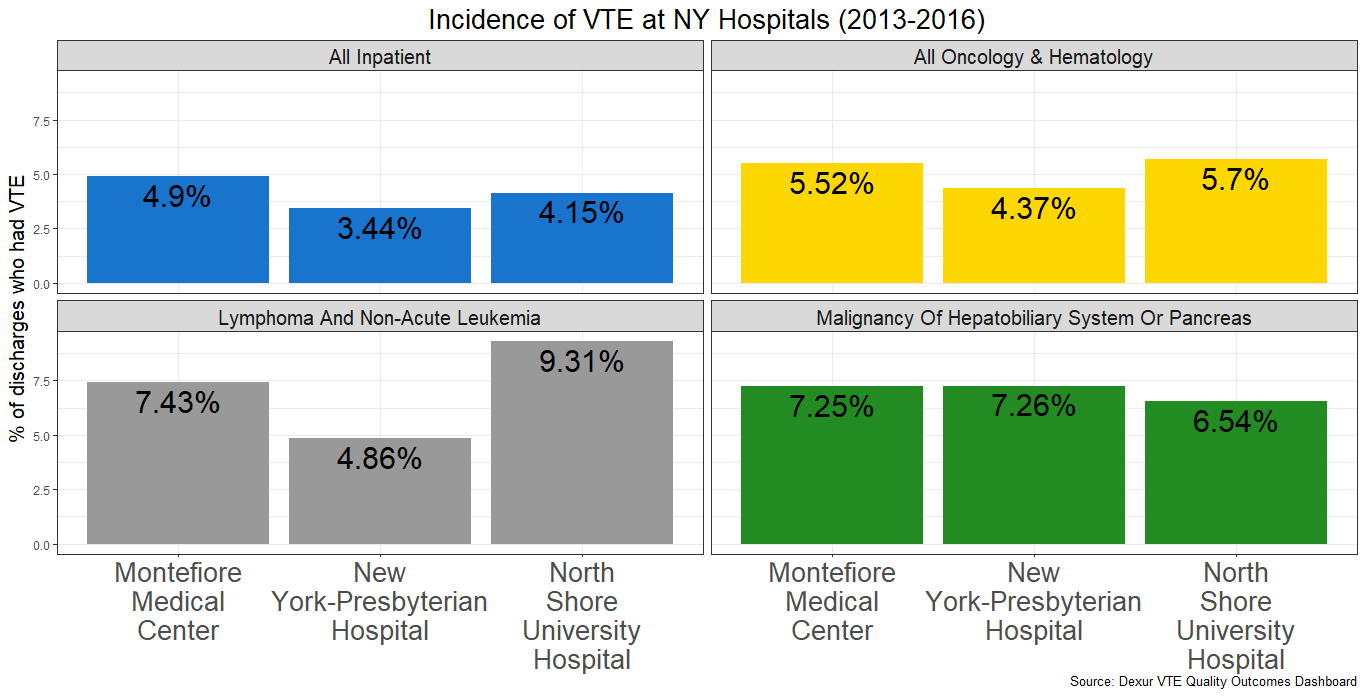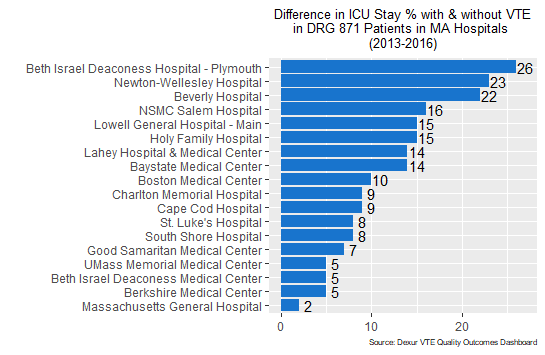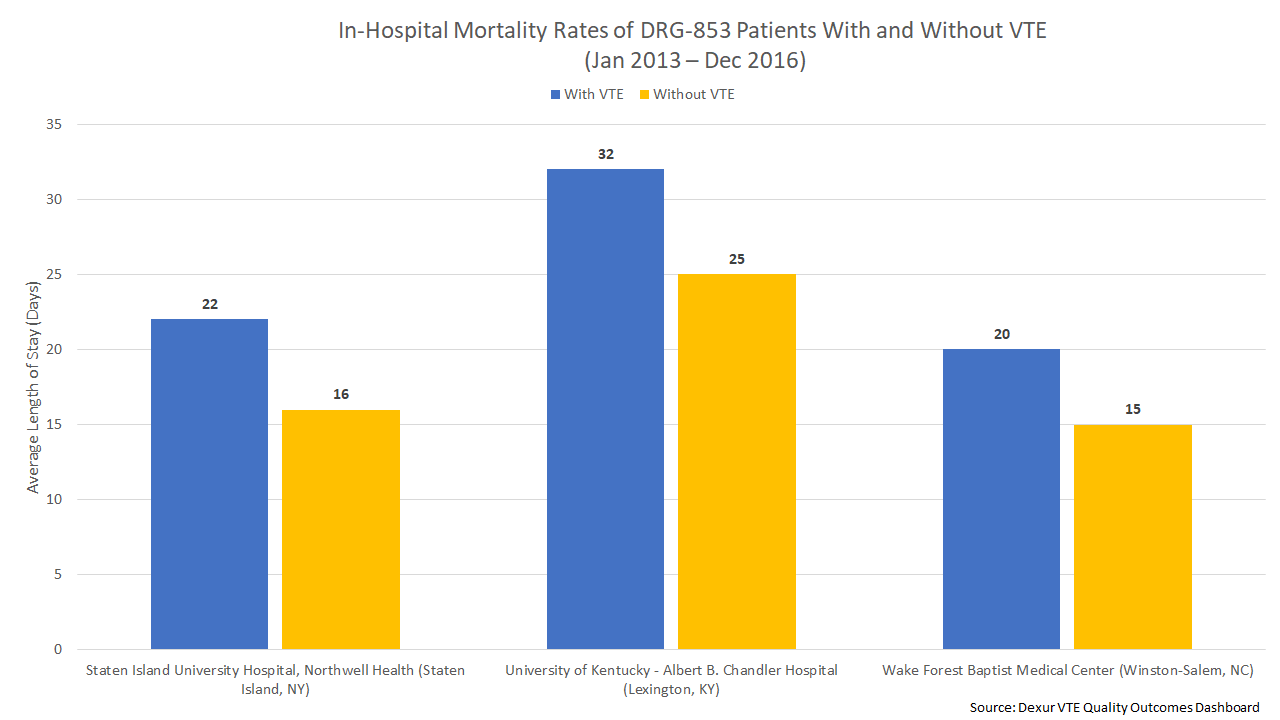Venous Thromboembolism (VTE)
Get Dexur’s Personalized Hospital Specific Presentation on Quality, Safety, Compliance & Education

By: James Pitt Aug. 13, 2018
Hospitalized patients are at greater risk of venous thromboembolism than the general population, in part because immobility increases VTE risk. According to the CDC report on healthcare-associated VTE, up to 70% of HA-VTE cases are preventable.
Read more
By: James Pitt Jul. 26, 2018
Venous thromboembolism (VTE) is a common and often preventable condition in which a blood clot forms, breaks loose, and lodges elsewhere. A June 26, 2018 study in Journal of the American Heart Association by Secemsky et. al analyzed CMS data on all-cause readmissions after VTE discharges from 2010-2014. From 2010-2014, 17.5% of patients discharged alive after acute VTE were readmitted to the hospital within 30 days. Secemsky et. al attribute a total $10 billion in annual US healthcare costs to VTE, and report that these 30-day readmissions account for “a nationally weighted annual cost totaling $1.44 billion.”
Read more
By: James Pitt Jun. 20, 2018
Venous thromboembolism (VTE) is a condition in which a blood clot forms in a vein, then may dislodge and block blood supply elsewhere. VTE is a common comorbidity of sepsis. The Surviving Sepsis Campaign recommends that patients with severe sepsis receive daily prophylaxis against VTE, with both pharmacologic therapy and pneumatic compression devices when possible.
Read more
By: James Pitt Jun. 05, 2018
Venous thromboembolism (VTE) is a condition in which a blood clot breaks loose and travels in the blood, often cutting off circulation in a vessel. Cancer and cancer treatment are risk factors for VTE, and a 2007 paper found VTE occurred in 4.1% of US cancer patients, rising to 5.7% among patients on chemotherapy. VTE risk model calculators such as the International Medical Prevention Registry on Venous Thromboembolism (IMPROVE) take cancer into account. To investigate VTE risk among cancer patients, Dexur analysts examined the incidence of venous thromboembolism in cancer among CMS inpatients discharged at three major New York hospitals from 2013-2016.
Read more
By: James Pitt May. 03, 2018
Venous thromboembolism (VTE) is a condition in which a blood clot forms in a vein, then may dislodge. According to the American Heart Association, it is “the third leading vascular diagnosis after heart attack and stroke, affecting about 300,000–600,000 Americans each year.” ; The Cleveland Clinic has a higher estimate of 1 million Americans per year.
Read more
By: Saparja Nag Apr. 24, 2018
The EkoSonic™ Endovascular system, produced by EKOS of BTG Interventional Medicine, is an innovative treatment for venous thromboembolism (VTE). It combines ultrasound technology and traditional thrombolytic medicines to more efficiently dissolve blood clots. More information as to how this unique system works can be found in a previous article about EKOS. One of the most prevalent comorbidities of VTE is infectious disease, as they share similar pathways of coagulation, inflammatory processes, and fibrinolysis processes. In infectious disease, these biological responses are caused both by the pathogens themselves and by the immune system’s response. Inflammation’s effects on hemostasis can often lead to thrombosis, presenting a serious risk for patients with infections.
Read more
By: Saparja Nag Apr. 10, 2018
The EKOS system, by BTG Interventional Medicine, offers an innovative treatment option for patients with pulmonary embolisms by combining thrombolytic medicines and ultrasound waves to dissolve blood clots. The EkoSonic™ Endovascular system utilizes Acoustic Pulse Thrombolysis™ to target and thin fibrin in order to dissolve a blood clot, which occurs by making the fibrin more porous and creating a pressure gradient to deliver the thrombolytics deeper within the clot. This therapeutic system offers multiple benefits over other venous thromboembolism (VTE) interventions including lowered risk of bleeding and other complications by targeting the clot specifically without affecting surrounding vessels, valves, or walls, and lower dosage requirements compared to both catheter-directed drug delivery and traditional systemic delivery via the circulatory system. The use of the EkoSonic™ Endovascular system provides a number of advantages over more traditional treatment options of VTE and thus may significantly affect mortality rates for certain conditions.
Read more